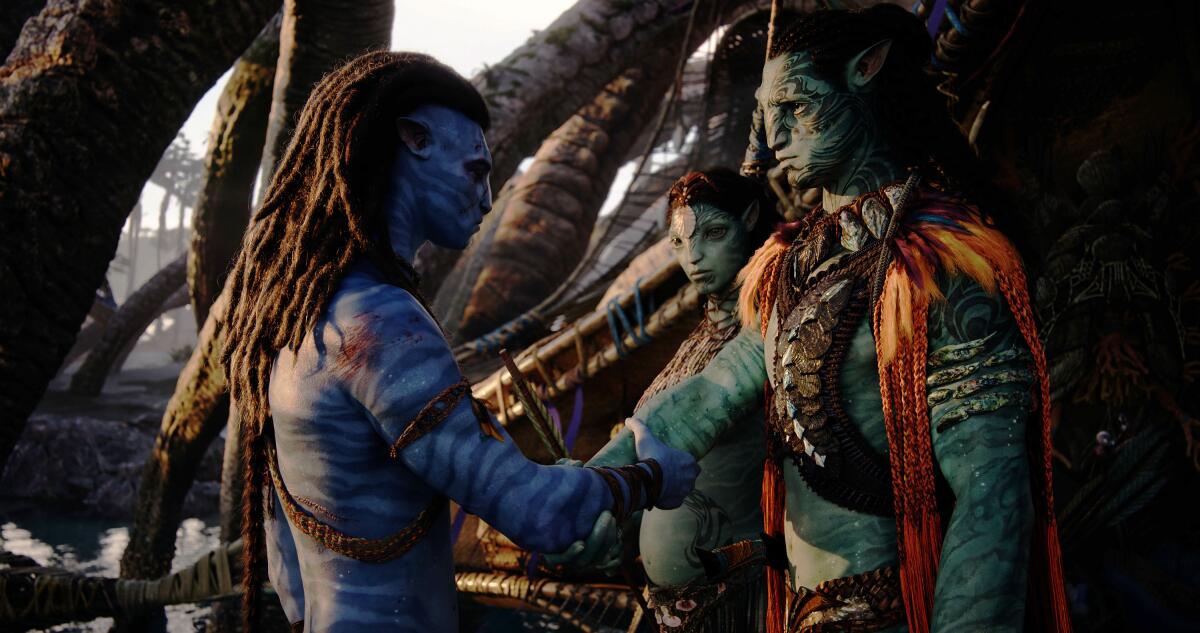Return to Pandora with ‘Avatar: The Way of Water’

- Share via
Hello! I’m Mark Olsen. Welcome to another edition of your regular field guide to a world of Only Good Movies.
Two new roundtables. For the Envelope, Michael Ordoña led a conversation with six actors, covering everything from working with directors to thoughts on mortality. Joining him were Austin Butler for “Elvis,” Paul Dano for “The Fabelmans,” Brendan Fraser for “The Whale,“ Jonathan Majors for “Devotion,” Bill Nighy for “Living” and Adam Sandler for “Hustle.”
Anousha Sakoui and Ryan Faughnder spoke to a group of six executives about the state of the business in Hollywood for Company Town. Taking part were Abhijay Prakash, president of Blumhouse; Jim Burtson, president of CAA; Stacey Snider, co-founder and CEO of Sister; Charles D. King, founder and CEO of Macro; Nina L. Diaz, president of content and chief creative officer for Paramount Media Networks and MTV Entertainment Studios; and Tony Vinciquerra, chairman and CEO of Sony Pictures Entertainment.
Only good movies
Get the Indie Focus newsletter, Mark Olsen's weekly guide to the world of cinema.
You may occasionally receive promotional content from the Los Angeles Times.
Irene Cara remembered. On Dec. 21, American Cinematheque launches a series to celebrate the career of Oscar-, Golden Globe- and Grammy-winning singer and actor Irene Cara, who recently died at age 63. Screening in the series will be Alan Parker’s 1980 “Fame,” Adrian Lyne’s 1983 “Flashdance” (in 35-millimeter) and Sam O’Steen’s 1976 “Sparkle.”
Inside the L.A. Film Critics vote. The Los Angeles Film Critics Assn., of which I am a member, voted on their picks for the best films of the year, with “Tár” and “Everything Everywhere All at Once” tying for best picture. Justin Chang and Glenn Whipp continued their recent tradition of giving some insider insight into the results.
Enjoying this newsletter? Consider subscribing to the Los Angeles Times
Your support helps us deliver the news that matters most. Become a subscriber.
‘Avatar: The Way of Water’
Directed and co-written by James Cameron, “Avatar: The Way of Water” is a sequel to the highest-grossing film of all time, the filmmaker’s 2009 “Avatar.” (No pressure.) The film returns to the spectacular planet of Pandora, picking back up with the family of Jake Sully (Sam Worthington), a human who has become part of the Na’vi people, who must fight human invaders looking to strip the natural resources of the planet. The cast also includes Sigourney Weaver, Kate Winslet, Zoe Saldaña, Cliff Curtis, Stephen Lang and more. The film is in theaters now.
For The Times, Justin Chang wrote, “Even coming from a filmmaker used to setting intimate relational sagas against large-scale tragedy, the tenderness and occasional sentimentality with which Cameron invests this drama of family conflict and survival feels unusually personal. It can also feel a bit thinly stretched at three hours, but even that seems more an act of generosity than indulgence on Cameron’s part; his attachment to this family is real and in time, so is yours. Audiences expecting propulsive non-stop action, rather than the director’s customary slow build, may be surprised to find themselves watching a leisurely saga of overprotective parents and rebellious teens, biracial/adoptive identity issues and casual xenophobia. … Like its predecessor, ‘Avatar: The Way of Water’ is both an environmental cautionary tale and a madly effective opportunity to root against our own kind; by the time the third act kicks in, you’ll be screaming for human blood.”
Ryan Faughnder wrote about what the movie might mean for the business of movie exhibition, in part because Cameron himself has said the movie will need to be among the highest-grossing films of all time just to turn a profit. As Cameron was reported to have said at the film’s world premiere in London, “Tonight is not just about a new ‘Avatar’ film. It’s about the cinema itself.”
For the New York Times, A.O. Scott wrote, “Cameron’s embrace of the idealism of adolescence, of the capacity for moral outrage as well as wonder, is the emotional heart of the movie. … I’m curious, and inclined — as I was in 2009 — to give this grand, muddled project the benefit of the doubt. Cameron’s ambitions are as sincere as they are self-contradictory. He wants to conquer the world in the name of the underdog, to celebrate nature by means of the most extravagant artifice, and to make everything new feel old again.”
For Rolling Stone, K. Austin Collins wrote, “‘The Way of Water’s’ structural backbone is something of a lost art, though, not because it’s some work of complex genius, but because, despite designing a story spread across multiple films, Cameron still seems intent on making each chapter stand alone as if there won’t be another. There’s something engagingly desperate about it. The movie proceeds in large, breathy movements, with expansive set pieces urging us forward and a morass of big human emotions keeping it afloat amid all the detours and details. The pieces click together on steady character beats, the kind that can reel you in even if you know what’s going to happen. Renegades gonna renegade; lovers gonna love; a compelling movie knows that you’re clued in and makes you want to see it happen, anyway.”
For the Washington Post, Ann Hornaday wrote, “If wanton destruction punctuated by moments of psychedelic visual splendor and New Age-y philosophizing is your bag, ‘The Way of Water’ provides plenty of value. … The action in ‘The Way of Water’ is ultimately overwhelming, betraying an uncomfortable truth about Cameron: He might preach environmentalism and balance, calling on Indigenous peoples for their gentle worldviews and material culture. But at heart, he’s just as aggressive and all-commanding as the bad guys he portrays with such oorah swagger. As the annihilation reached its punishingly fevered pitch at a recent screening, the crashes and rumbles and explosions weren’t just deafening, they were palpable to the point that I wondered who was kicking my seat. Then I realized: It was James Cameron all along.”
For Vulture, Bilge Ebiri wrote, “Cameron has always been an artist divided: equal parts gearhead and tree hugger, swaggering stud and soft-focus softie. That’s the secret of his success as a showman. … Cameron’s divided self finds its fullest expression on Pandora not just because he can create vast new worlds and matrices of spiritually interconnected beings but also because he can fight battles he can’t fight elsewhere. For even here, he’s ultimately telling an Earth story. He channels his (and our) inchoate rage at the devastation of the natural world, and he delivers a fantasy of revenge — albeit one set on a strange shore in a distant galaxy, one that just happens to look like a heightened, trippy version of our own.”

Enjoying this newsletter? Consider subscribing to the Los Angeles Times
Your support helps us deliver the news that matters most. Become a subscriber.
‘The Quiet Girl’
Written and directed by Colm Bairéad, adapting a short story by Claire Keegan, “The Quiet Girl” tells the tale of a young girl named Cáit (Catherine Clinch), who is sent to live for a summer in the countryside with distant relatives. Ireland’s entry for the international feature Oscar, the film is in theaters now.
For The Times, Robert Abele wrote, “Everything in this heartfelt tale is made with the deepest sincerity, and gently packed with soulful portrayals and lovely imagery. … The key takeaway from ‘The Quiet Girl’ is how rare cinematic depictions of everyday, unadorned sympathy are without the common narrative’s machinery of motive. I’ll admit to thinking, on first viewing, that there was too little to ‘The Quiet Girl,’ that an absence of incident was a sign of willful preciousness. A second, closer look disabused me of that. It would be better to view this fine film as deceptively small, revealing its own distinctively filigreed array of the gentle and good in all that meaningful silence.”
For the Guardian, Peter Bradshaw declared, “already it feels to me like a classic,” while adding, “In another kind of movie, a lazier kind, all this stillness and rural beauty, seen by an enigmatically silent child who is accustomed to vanishing invisibly into the landscape, would be the ominous foretaste of something horrible or violent to come just before the final credits. But ‘The Quiet Girl’ is doing something gentler than this, as well as realer and truer. It is a jewel.”
For Variety, Jessica Kiang wrote, “At a stretch, we could see in Cáit’s reticence some sort of analogy for her native Irish tongue — there’s a certain eloquence in having such an inarticulate character speak a language that was, and still is, in danger of being silenced. But the unwavering focus of Bairéad’s impressively controlled debut feature doesn’t really allow for much subtext, nor for much surprise. Even that doesn’t really matter: Though you can foretell the way the story must end right from the moment Seán bids Cáit a curt goodnight without even turning his head from the TV, the cumulative power of ‘The Quiet Girl’ means that when that ending duly comes, it’s remarkably moving. For all the things that can be lost in the quiet, sometimes people can find each other there.”

‘The Runner’
Directed by Amir Naderi, the 1984 film “The Runner” has been rereleased, bringing back one of the first films from the Iranian New Wave of the post-revolution era. Set in the Southern port city of Abadan, the story follows an 11-year-old orphan named Amiro (played by Madjid Niroumand, who now lives in California) as he goes about the daily business of living with an irrepressible spirit. The film is in theaters now.
For The Times, Robert Abele wrote, “‘The Runner’ is sweetly kinetic, full of life, at times even operatic, but also paradoxically unsentimental. … ‘The Runner’ hardly feels like an artifact, its artistry only burnished over time through Firooz Malekzadeh’s deeply textured cinematography and Bahram Beyzaie’s faultless cutting. But you can see why — in the unblinking honesty descended from Italian neorealism, with its nonprofessional casting and social trenchancy, combined with the personal expression reminiscent of French New Wave — ‘The Runner’ hit international film audiences of the time like a newly discovered color in a spectrum that features Buster Keaton, Vittorio De Sica and François Truffaut.”
For the New York Times, J. Hoberman wrote, “In effect, the movie naturalizes the urban environment. The light is often dazzling; the array of bottles floating in the harbor is bewitching. While acknowledging that every object in Amiro’s world has its price, ‘The Runner’ has a subtle fairy-tale quality. … Paradoxical to the end, ‘The Runner’ concludes with a near-silent tumult of fire and ice, and a sense of triumph founded on the realization that the adult Amiro made this movie.”
Reviewing the film upon its original release, The Times’ Kevin Thomas (celebrated in Quentin Tarantino’s new book, “Cinema Speculation”) said that the film is “a work of astonishing power and simplicity,” also noting, “It dares to suggest that for the dispossessed, life in Iran is as hard as it was under the Shah. Yet it is possible to see why the film got by the censors in Iran, for it ostensibly offers hope, extolling the implacable determination of its appealing little hero Amiro (Madjid Niroumand) to survive and even better himself, learning to read and write. Yet its stunningly ambiguous finish, involving Amiro and his pals in a foot race, is set against a blazing oil field that invites symbolic criticism of the Khomeini regime.”
Only good movies
Get the Indie Focus newsletter, Mark Olsen's weekly guide to the world of cinema.
You may occasionally receive promotional content from the Los Angeles Times.




